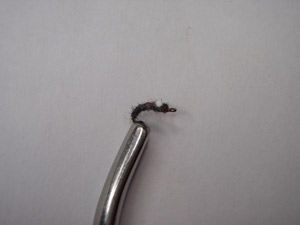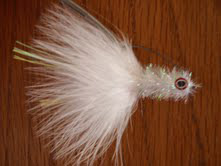OLD FART
BY MARLA BLAIR
Yes you read it right the old fart, It’s a cousin of the original pattern Blair’s emerger. It’s like a nymph/emerger pattern the white closed-cell foam acts like an air bubble or wing case fish it deep, using split shot and a strike indicator. Remember if you are not getting any strikes and you’re not hooking the bottom of the stream you are probably not deep enough.
HOOK - Daiichi #1150 (has the eye up) or I used Mustad C495 or TMC 2488 (has the eye straight) or a similar scud hook, sizes #20-#14
THREAD - Pink 8/0 (70 Denier) or 40 (140 Denier) depending upon the size of the fly.
WING CASE - 1mm white closed-cell foam
BODY - Adams gray super fine dubbing. I used dark gray fly rite (it matched the pattern better)
How to Tie
- Debarb hook and place in the vice. Start thread at the front of the hook about two eyelets from the eye and lay down a thread base about half way down the hook shank.
- Cut a foam strip wide enough so that it will cover the upper half of the thread base when folded into position. Tie the foam securely over the thread base on top at the mid shank point of the hook and the tag end facing the hook bend and working forward. Then clip off as much of the tag end as you can. And cover it with thread. Remember to not crowd the head. One eyelet from the eye is good. You will need the space for dubbing.
- Bring your thread back then fold the foam back and lean the foam toward you as you tie it down. This will move to the top and you will have foam on each side of the shank. Clip off the excess foam tag. Cover the tag end with thread wraps. Don’t leave any white tag ends showing. It seems to bleed through the dubbing.
- Wrap a smooth underbody. It should extend halfway into the hook bend and tapered with the thick side up against the thorax. End your thread underbody up against the foam.
- Dub the super fine starting at the rear of the thorax foam then make one or two crossing wraps (figure eight) under the thorax area of the hook. Try and guess how much dubbing you will need so you end the dubbing at the hook bend (I used about one inch for a #18 hook) Remember it’s easier to add more dubbing than it is to remove some. Continue wrapping the dubbing down the hook to create the body of the fly. You should run out of dubbing just as you reach the end of the under body thread.
- Loosely spiral-wrap the bare thread forward to create the rib. Whip-finish and clip the thread and you’re done.
A VERY SIMPLE TIE. Also try using other super fine colors like caddis green- mahogany brown- rusty brown- pale yellow- BWO just change the thread to a slight contrasting color and the rest of the pattern is the same. You can tie up three dozen in less than one hour.






